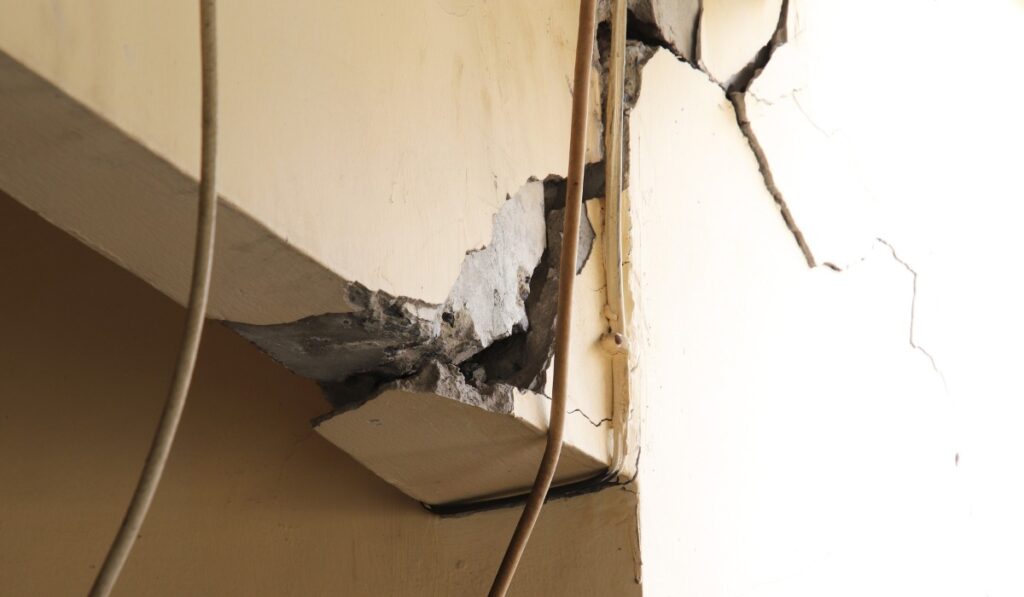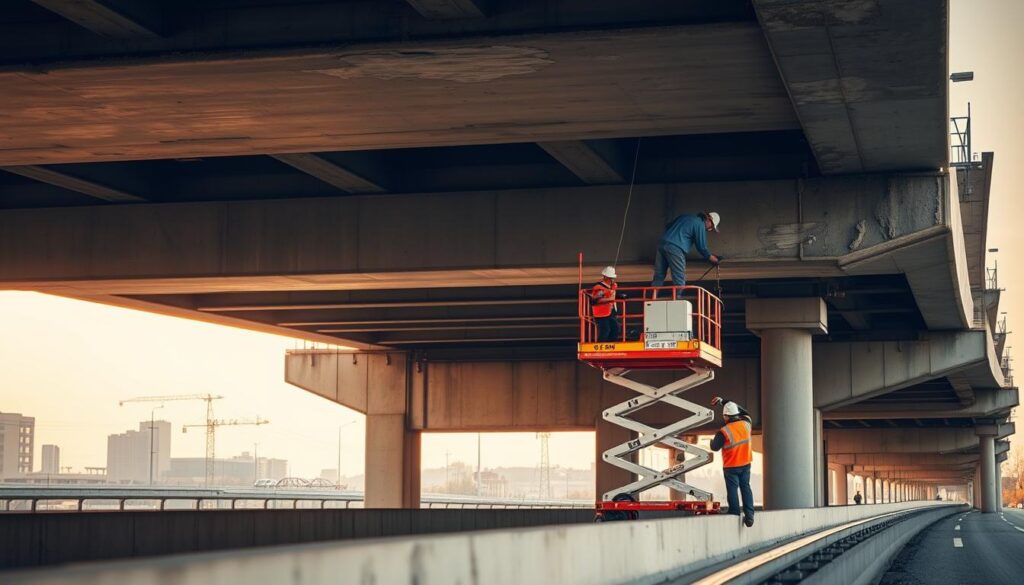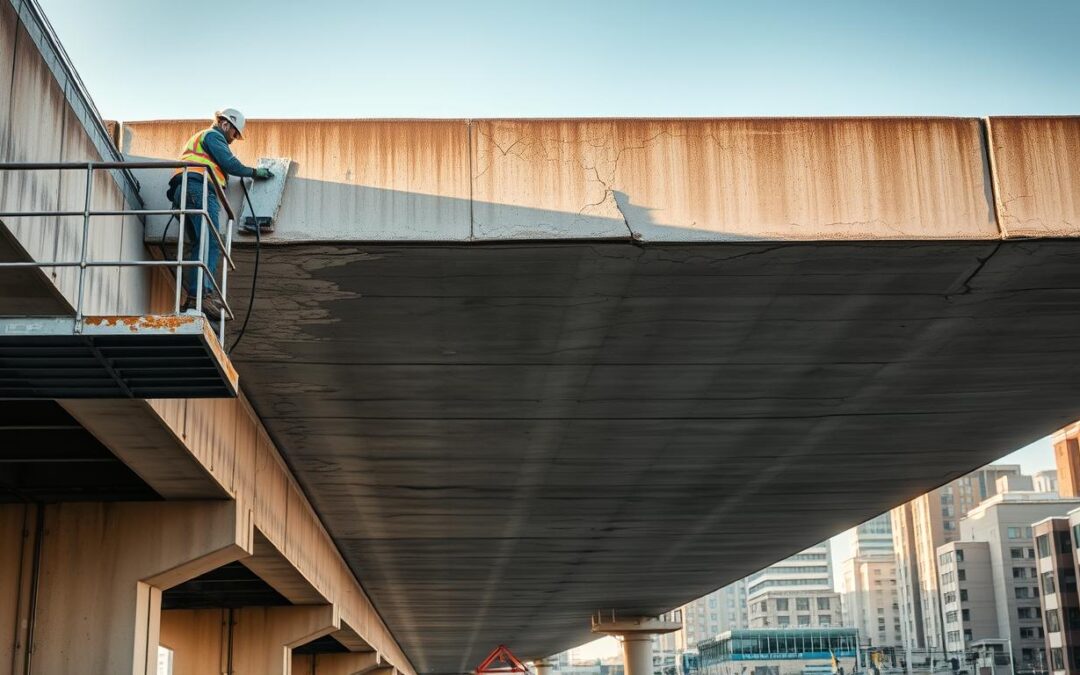Concrete spalling under bridges is a big problem that can cause serious damage if not fixed quickly. Keeping bridges in good shape is key to making them last longer.
Fixing concrete spalling needs careful planning and doing. It’s important to place under-bridge platforms right to make patching safe and effective.
Knowing why spalling happens and how to fix it helps maintenance teams act fast. The right placement of platforms is vital for fixing concrete well, keeping bridges strong.
Key Takeaways
- Concrete spalling under bridges is a significant maintenance issue.
- Effective bridge maintenance is key for infrastructure longevity.
- Proper platform positioning is key to successful concrete spalling repair.
- Under-bridge platforms help make repairs safe and efficient.
- Proactive maintenance can extend the lifespan of bridges.
Understanding Concrete Spalling in Bridge Structures
It’s important to know why concrete spalling happens to keep bridges safe and strong. Concrete spalling is when the surface breaks or flakes off, showing the steel underneath. This can weaken bridges, leading to expensive fixes or even failures.
What Causes Concrete Spalling Under Bridges
Several things can cause concrete spalling under bridges. Environmental factors, traffic, and material wear are main culprits. “Corrosion of steel, freeze-thaw cycles, and heavy traffic are key reasons for spalling” (CP-Tech, n.d.). For more on bridge defects, check Under Bridge Platforms. Regular checks can spot problems early.
Identifying the Severity of Spalling Damage
Knowing how bad spalling damage is helps choose the right fix. Inspections like sounding and looking closely are used to figure out the damage. “Checking how bad spalling is helps pick the best materials and methods for concrete deterioration repair.” Good checks help teams focus on the most urgent repairs, keeping bridges in good shape.
Repairing Concrete Spalling Under Bridges: Planning and Assessment
Effective bridge spalling restoration needs careful planning and assessment. This ensures the structural integrity of the bridge. Before starting repairs, a thorough evaluation of the bridge’s condition is essential.
Safety Considerations and Required Permits
Safety is the top priority in bridge repair. Getting the right permits and following strict safety rules is key. A concrete repair specialist knows all about these steps.
Essential Tools and Materials for Bridge Repair
Choosing the right tools and materials is critical for a successful structural repair. The materials must be durable and compatible to last long. For under-bridge access, picking the correct platform is also important. More details are available at https://underbridgeplatforms.com/understanding-load-capacities-and-reach-choosing-the-right-under-bridge-platform/.

Cost Estimation and Project Timeline
Creating a detailed cost estimate and project timeline is vital. This involves checking the damage, materials needed, and labor required. It ensures the project stays within budget and is finished on time.
Platform Positioning Techniques for Under-Bridge Access
The success of bridge maintenance projects often depends on the strategic deployment of under-bridge access platforms. These platforms provide workers with safe and efficient access to areas that are difficult to reach. They facilitate both inspection and repair tasks.
Types of Access Platforms for Bridge Repair
There are various types of under-bridge platforms available. Each is designed for different bridge designs and repair needs. Truck-mounted platforms offer mobility and flexibility. Self-propelled units provide stability and precision. The choice of platform depends on the project’s specific needs, including the bridge’s size and repair type.
| Platform Type | Key Features | Application |
|---|---|---|
| Truck-Mounted | Mobile, adjustable height | Large bridges, complex repairs |
| Self-Propelled | Stable, precise positioning | Smaller bridges, routine maintenance |
Strategic Platform Placement for Different Bridge Designs
Strategic placement of under-bridge platforms is critical for effective bridge repair. The bridge’s design, including its height, span, and structural elements, influences platform positioning. For instance, bridges over water require platforms that can be securely positioned to prevent movement caused by wind or water currents.
“The positioning of under-bridge platforms must be carefully planned to ensure worker safety and facilitate efficient repair work.”
Securing and Stabilizing Work Platforms in Challenging Environments
Securing and stabilizing under-bridge platforms is challenging in environments like over water or in high winds. Techniques such as anchoring the platform to the bridge structure or using counterweights can enhance stability. Regular inspections of the platform and its securing mechanisms are essential to maintaining a safe working environment.
By understanding the different types of under-bridge platforms and employing strategic placement and securing techniques, bridge maintenance professionals can ensure safe and effective repair operations.
Step-by-Step Process for Concrete Spalling Repair
Fixing concrete spalling under bridges is a detailed process. It starts with checking the damage and then making a repair plan.
Removing Deteriorated Concrete and Surface Preparation
The first step is to take out the bad concrete. This is done with hydrodemolition or mechanical methods. It makes sure all damaged parts are gone without hurting the structure more.
After removing the bad parts, the surface is cleaned and ready for the repair material.
Getting the surface ready is key. It helps the new material stick well to the old concrete. This might mean surface roughening or using a bonding agent.
Treating Exposed Reinforcement Steel
Steel that’s exposed needs to be treated to stop rust. First, clean the steel to get rid of rust or dirt. Then, apply a corrosion-inhibiting coating. This step is important for the repair to last long.
Selecting and Applying Appropriate Patching Materials
Choosing the right patching material is important. It depends on the damage, the environment, and the look you want. Materials like polymer-modified mortars and high-performance concretes are common. The material is applied as the maker says, for a strong and lasting fix.
For more info on fixing spalling concrete, check out this resource.
Curing and Finishing Techniques for Durable Repairs
After putting on the patching material, it’s important to cure it right. This might mean moist curing or using a curing compound. The repair should be checked to make sure it’s strong and looks good.
Good curing and finishing are key for the repair to last. Regular checks can spot problems early.
Quality Control and Long-Term Maintenance
To make sure bridge repairs work well, a detailed quality control and maintenance plan is key. This means the repairs must be top-notch and the bridge safe and working well for a long time.
Testing Repaired Areas for Structural Integrity
After the repairs, it’s important to test the fixed areas to check their strength. Non-destructive testing techniques are used to check the repairs without harming the bridge. Experts say, “Regular testing is vital to ensure the durability of the repairs and the overall safety of the bridge structure.”
“The integrity of the repair is just as important as the repair itself.”
These tests can include ultrasonic pulse velocity, impact-echo testing, or other methods. They help confirm the quality and strength of the fixed concrete.

Preventative Measures to Reduce Future Spalling
Preventive steps can greatly lower the chance of future spalling. Regular checks are key to spot problems early. Keeping drainage systems working and using protective coatings on weak spots are also good ideas. These actions help keep the bridge in good shape for longer and save money in the long run.
Some important preventive steps include:
- Regularly inspecting the bridge for signs of deterioration
- Maintaining and cleaning drainage systems
- Applying protective coatings to exposed concrete
By doing these things, bridge owners can make sure their bridges last a long time.
Conclusion
Fixing concrete spalling under bridges is key to keeping our infrastructure safe and strong. Knowing why spalling happens, like when steel corrodes, helps us fix it right. This way, we keep our bridges safe for everyone.
Under-bridge platforms are very important. They give us a safe way to get to hard-to-reach places. This is vital for keeping our bridges in good shape.
Regular upkeep is a must. A study showed that fixing spalling costs about $40 million a year. A study on bridge deck repair shows how important it is to know how bad the damage is. Using the right methods for fixing it is also key.
By focusing on maintenance and using new technologies, we can keep our bridges strong. This helps them last longer and stay safe for everyone.
Good bridge maintenance means using the right tools and techniques. It also means keeping up with maintenance over time. This way, we can avoid more problems and keep our communities safe.


Recent Comments